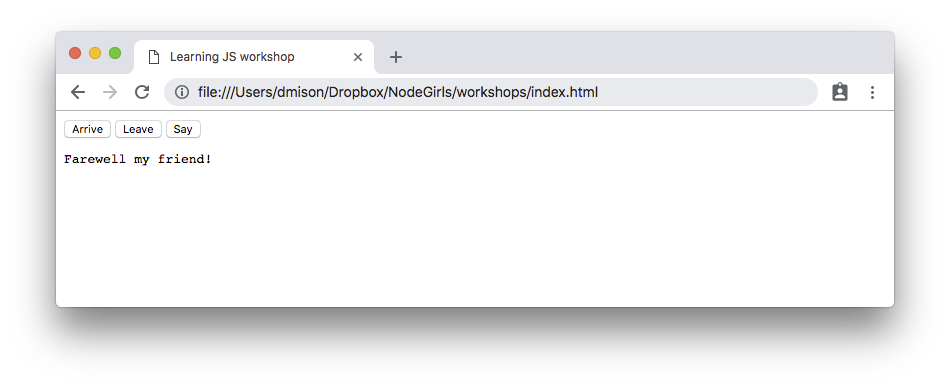Workshop Steps
- 0 - About Programming
- 1 - Setting Up
- 2 - Values and operations
- 3 - Variables
- 4 - Conditions
- 5 - Array
- 6 - Objects
- 7 - Functions
- 8 - Functions and Objects
- 9 - Loops
- 10 - External Scripts
- 11 - The DOM
- 12 - And now what?
Useful Links
Step 3 - Variables
So now we know the basics about values, operations and expressions.
But so far we have only been able to write literal values. We have needed to know what they will be ahead of time. What if we don’t know yet or if we expect them to change over time? That’s where variables come in.
Variables are named placeholders that represent a value.
To create a new variable you declare its name using the keyword var:
var message;
This created a new variable with the name of message.
Variable names:
- can contain letters, digits, underscores, and dollar signs.
- must begin with a letter
- are case sensitive (
messageandMessageare different variables) - cannot be reserved words (eg.
var)
Once you have created a variable, you assign a value to it using the assignment operator =.
message = 'Hello There!';
You can also create and assign in a single statement:
var message = 'Hello There!';
Assigning a value at the time of creation is sometimes called providing an initial value or initialising the variable.
You can think of a variable as being like a labeled box that you put a value into, and then you can use that value by referring to the box by its label.
So for example you could change the doStuff() function like this:
function doStuff(){
var message = 'You clicked the button';
document.getElementById('displayBox').innerText = message;
}
That’s kind of an academic example though, it doesn’t really demonstrate why you use variables.
Let’s do a better one.
We’re going to update the page so it has three buttons, labelled Arrive, Leave, and Say.
When you click on Say it will display a message that is saved in a variable.
Clicking on Arrive and Leave will change the message that is stored.
Let’s create another page like this:
<!DOCTYPE html>
<html>
<head>
<meta charset="utf-8">
<title>Learning JS workshop</title>
</head>
<body>
<button id="arriveButton">Arrive</button>
<button id="leaveButton">Leave</button>
<button id="sayButton">Say</button>
<pre id="displayBox"></pre>
</body>
<script>
var message = "I don't know where you are!";
function handleArrive(){
message = 'Welcome!';
}
function handleLeave(){
message = 'Farewell my friend!';
}
function sayStuff(){
document.getElementById('displayBox').innerText = message;
}
document.getElementById('sayButton').onclick = sayStuff;
document.getElementById('arriveButton').onclick = handleArrive;
document.getElementById('leaveButton').onclick = handleLeave;
</script>
</html>
In our JavaScript we have a variable called message.
message is what is displayed when we click on the Say button.
Clicking on either of the other buttons will assign a different value to message.

Before going on to the next step, have a try at adding another button Stay which changes the message to "Well, make yourself comfortable."
 Muses Code
Muses Code